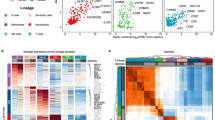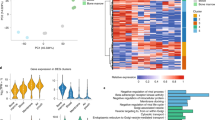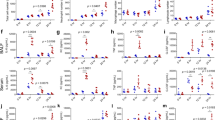Abstract
Epithelium-specific Ets transcription factor 1 (ESE-1) is a member of the E26 transformation-specific family of transcription factors that has an epithelial-restricted constitutive expression but is induced by inflammatory stimuli in non-epithelial cells. Here we report that ESE-1 is constitutively expressed in human, but not in murine, neutrophils and that ESE-1 is modestly upregulated in septic patient neutrophils. In normal human neutrophils, ESE-1 was detected at both RNA and protein levels but was found to be an unstable nuclear protein ex vivo. ESE-1 transcription was also induced during all-trans retinoic acid-mediated HL-60 differentiation, a human promyelocytic cell line often used as an in vitro model of human neutrophils. Elf3−/− mice had normal neutrophils but a reduced number of circulating B-lymphocytes. These findings indicate a potential role of ESE-1 in regulating human neutrophil differentiation and function, and that it has different roles in the immune system of different species.
This is a preview of subscription content, access via your institution
Access options
Subscribe to this journal
Receive 6 digital issues and online access to articles
$119.00 per year
only $19.83 per issue
Buy this article
- Purchase on Springer Link
- Instant access to full article PDF
Prices may be subject to local taxes which are calculated during checkout


Similar content being viewed by others
References
Maroulakou IG, Bowe DB . Expression and function of Ets transcription factors in mammalian development: a regulatory network. Oncogene 2000; 19: 6432–6442.
Bartel FO, Higuchi T, Spyropoulos DD . Mouse models in the study of the Ets family of transcription factors. Oncogene 2000; 19: 6443–6454.
Tymms MJ, Ng AY, Thomas RS, Schutte BC, Zhou J, Eyre HJ et al. A novel epithelial-expressed ETS gene, ELF3: human and murine cDNA sequences, murine genomic organization, human mapping to 1q32.2 and expression in tissues and cancer. Oncogene 1997; 15: 2449–2462.
Oettgen P, Alani RM, Barcinski MA, Brown L, Akbarali Y, Boltax J et al. Isolation and characterization of a novel epithelium-specific transcription factor, ESE-1, a member of the ets family. Mol Cell Biol 1997; 17: 4419–4433.
Oliver JR, Kushwah R, Hu J . Multiple roles of the epithelium-specific ETS transcription factor, ESE-1, in development and disease. Lab Invest 2011; 92: 320–330.
Chang CH, Scott GK, Kuo WL, Xiong X, Suzdaltseva Y, Park JW et al. ESX: a structurally unique Ets overexpressed early during human breast tumorigenesis. Oncogene 1997; 14: 1617–1622.
Kaplan MH, Wang XP, Xu HP, Dosik MH . Partially unspliced and fully spliced ELF3 mRNA, including a new Alu element in human breast cancer. Breast Cancer Res Treat 2004; 83: 171–187.
He J, Pan Y, Hu J, Albarracin C, Wu Y, Dai JL . Profile of Ets gene expression in human breast carcinoma. Cancer Biol Ther 2007; 6: 76–82.
Wu J, Duan R, Cao H, Field D, Newnham C, Koehler DR et al. Regulation of epithelium-specific Ets-like transcription factors ESE-1 and ESE-3 in airway epithelial cells. Cell Res 2008; 18: 649–663.
Kushwah R, Oliver JR, Wu J, Chang Z, Hu J . Elf3 regulates allergic airway inflammation by controlling dendritic cell-driven T cell differentiation. J Immunol 2011; 187: 4639–4653.
Bjerregaard MD, Jurlander J, Klausen P, Borregaard N, Cowland JB . The in vivo profile of transcription factors during neutrophil differentiation in human bone marrow. Blood 2003; 101: 4322–4332.
Mantovani A, Cassatella MA, Costantini C, Jaillon S . Neutrophils in the activation and regulation of innate and adaptive immunity. Nat Rev Immunol 2011; 11: 519–531.
El Kebir D, Filep JG . Role of neutrophil apoptosis in the resolution of inflammation. ScientificWorldJournal 2010; 10: 1731–1748.
Beyrau M, Bodkin JV, Nourshargh S . Neutrophil heterogeneity in health and disease: a revitalized avenue in inflammation and immunity. Open Biol 2012; 2: 120134.
Grall F, Gu X, Tan L, Cho JY, Inan MS, Pettit AR et al. Responses to the proinflammatory cytokines interleukin-1 and tumor necrosis factor alpha in cells derived from rheumatoid synovium and other joint tissues involve nuclear factor kappaB-mediated induction of the Ets transcription factor ESE-1. Arthritis Rheum 2003; 48: 1249–1260.
Zhan Y, Yuan L, Kondo M, Oettgen P . The counter-regulatory effects of ESE-1 during angiotensin II-mediated vascular inflammation and remodeling. Am J Hypertens 2010; 23: 1312–1317.
Manavathi B, Rayala SK, Kumar R . Phosphorylation-dependent regulation of stability and transforming potential of ETS transcriptional factor ESE-1 by p21-activated kinase 1. J Biol Chem 2007; 282: 19820–19830.
Breitman TR, Selonick SE, Collins SJ . Induction of differentiation of the human promyelocytic leukemia cell line (HL-60) by retinoic acid. Proc Natl Acad Sci USA 1980; 77: 2936–2940.
Ozeki M, Shively JE . Differential cell fates induced by all-trans retinoic acid-treated HL-60 human leukemia cells. J Leukoc Biol 2008; 84: 769–779.
Boxio R, Bossenmeyer-Pourie C, Steinckwich N, Dournon C, Nusse O . Mouse bone marrow contains large numbers of functionally competent neutrophils. J Leukoc Biol 2004; 75: 604–611.
Slade E, Tamber PS, Vincent JL . The surviving sepsis campaign: raising awareness to reduce mortality. Crit Care 2003; 7: 1–2.
Marshall JC . Why have clinical trials in sepsis failed? Trends Mol Med 2014; 20: 195–203.
Raven K . Rodent models of sepsis found shockingly lacking. Nat Med 2012; 18: 998.
Mestas J, Hughes CCW . Of mice and not men: differences between mouse and human immunology. J Immunol 2004; 172: 2731–2738.
Hajjar E, Broemstrup T, Kantari C, Witko-Sarsat V, Reuter N . Structures of human proteinase 3 and neutrophil elastase—so similar yet so different. FEBS J 2010; 277: 2238–2254.
Zollner O, Lenter MC, Blanks JE, Borges E, Steegmaier M, Zerwes HG et al. L-selectin from human, but not from mouse neutrophils binds directly to E-selectin. J Cell Biol 1997; 136: 707–716.
Condliffe AM, Davidson K, Anderson KE, Ellson CD, Crabbe T, Okkenhaug K et al. Sequential activation of class IB and class IA PI3K is important for the primed respiratory burst of human but not murine neutrophils. Blood 2005; 106: 1432–1440.
Gentile LF, Nacionales DC, Lopez MC, Vanzant E, Cuenca A, Cuenca AG et al. A better understanding of why murine models of trauma do not recapitulate the human syndrome. Crit Care Med 2014; 42: 1406–1413.
Seok J, Warren HS, Cuenca AG, Mindrinos MN, Baker HV, Xu W et al. Genomic responses in mouse models poorly mimic human inflammatory diseases. Proc Natl Acad Sci USA 2013; 110: 3507–3512.
Morishima T, Watanabe K, Niwa A, Fujino H, Matsubara H, Adachi S et al. Neutrophil differentiation from human-induced pluripotent stem cells. J Cell Physiol 2011; 226: 1283–1291.
Watson RWG, Rotstein OD, Parodo J, Bitar R, Marshall JC . The IL-1β-converting enzyme (Caspase-1) inhibits apoptosis of inflammatory neutrophils through activation of IL-1β. J Immunol 1998; 161: 957–962.
Vancurova I, Miskolci V, Davidson D . NF-kappa B activation in tumor necrosis factor alpha-stimulated neutrophils is mediated by protein kinase Cdelta. Correlation to nuclear Ikappa Balpha. J Biol Chem 2001; 276: 19746–19752.
Livak KJ, Schmittgen TD . Analysis of relative gene expression data using real-time quantitative PCR and the 2(-Delta Delta C(T)) method. Methods 2001; 25: 402–408.
Acknowledgements
We thank Arthur Gutierrez-Hartmann (University of Colorado) for his generous gift of the pEGFP-C3-empty and pEGFP-ESE-1 vectors. This study was funded by Canadian Institute for Health Research (CIHR) grant (MOP 125882) to Jim Hu. Chan Mi Lee is a recipient of Ontario Graduate Scholarship (OGS), Peterborough K.M. Hunter Studentship and SickKids Restracomp Studentship. We acknowledge that no authors have conflicting financial interests.
Author information
Authors and Affiliations
Corresponding author
Ethics declarations
Competing interests
The authors declare no conflict of interest.
Rights and permissions
About this article
Cite this article
Lee, C., Gupta, S., Parodo, J. et al. The uncovering of ESE-1 in human neutrophils: implication of its role in neutrophil function and survival. Genes Immun 16, 356–361 (2015). https://doi.org/10.1038/gene.2015.10
Received:
Revised:
Accepted:
Published:
Issue Date:
DOI: https://doi.org/10.1038/gene.2015.10



